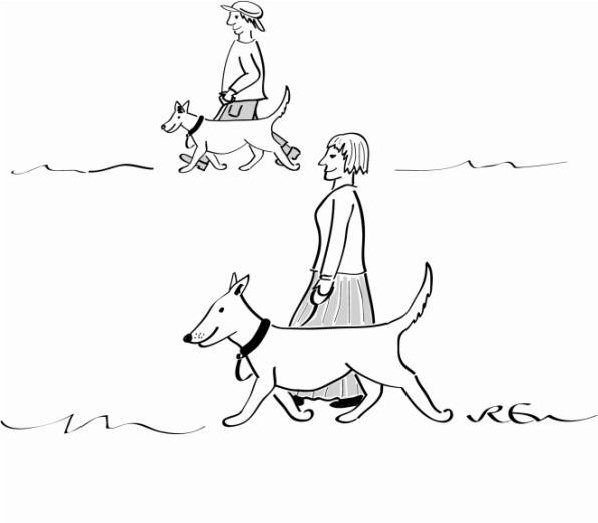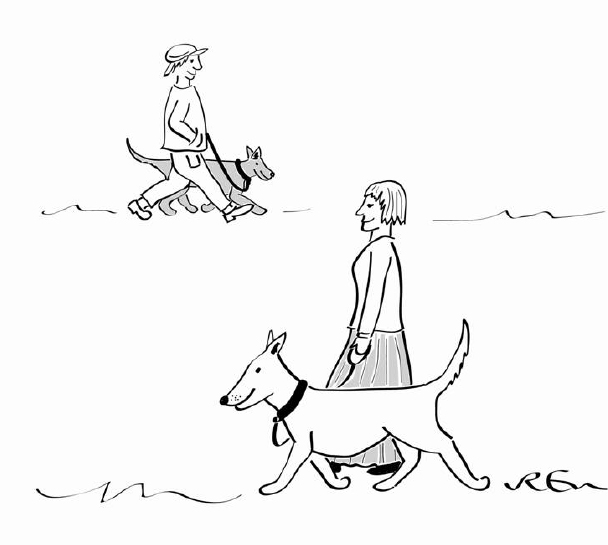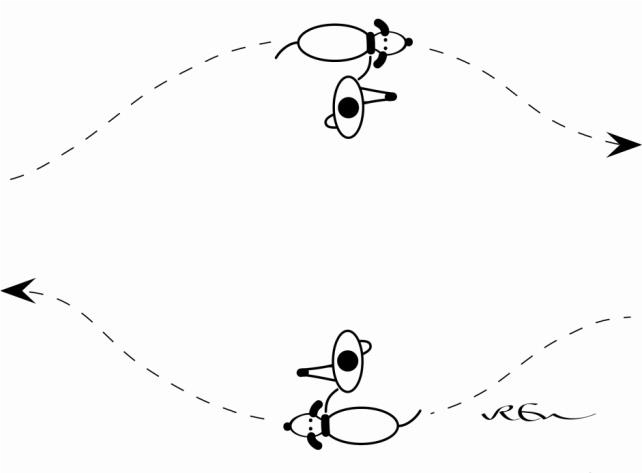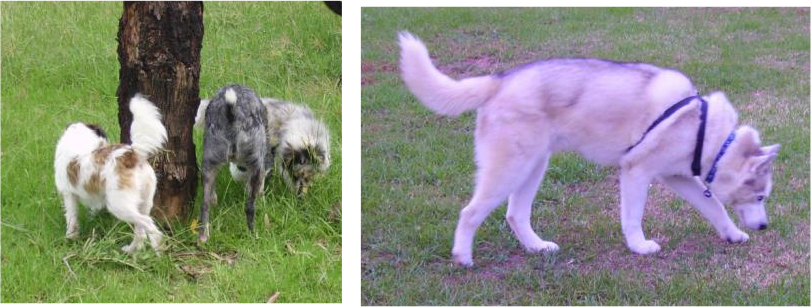Read The Art of Introducing Dogs Online
Authors: Louise Ginman
The Art of Introducing Dogs (6 page)
(Left) The introduction of a Pug puppy and a Siberian Husky took place off lead at the Pug’s home. Notice the tight mouth of the Siberian while the puppy has an open, relaxed mouth. The Siberian appears apprehensive. (Right) Introduction of a Shetland Sheepdog puppy to the Siberian. Notice the Siberian has a relaxed mouth and avoids eye contact by doing a ‘look away’ as the puppy looks at him. Both have adopted calm and relaxed postures.
This is the preferred type of introduction because we remove lead tension and our own anxieties which are easily transferred to the dogs. The off lead introduction should only be done where both socialisation histories are known and both dogs have had good positive ongoing socialisation, because once off lead, your control over what happens has gone or becomes quite limited.
This introduction method should be used for the introduction of puppies, juvenile and adult dogs to existing dog/s. Note though that puppy introductions should occur off lead at the breeders home or at the rescue/shelter where the puppy is housed and not in public places due to the risk of disease.
It is important that you remain calm during all introductions. Keep your breathing slow and be conscious of it because your dog is. Use a light and happy voice at all times, but especially if things look a bit tense. Always end the introduction on a positive note. It is best to begin with short durations and have positive interactions than to go for one long introduction where things get tense and/or a fight occurs. Remember, the most successful introductions are ones that are conducted for short durations that slowly build up to longer periods, are relaxed and fun and are conducted over a period of time.
Proceed to the off lead introduction after doing scent crossover. For really well socialised dogs — ones that have been going to a dog park, beach or other off leash area and playing off lead weekly with a whole variety of different dogs (and have an impeccable fight-bite ratio and bite inhibition), you could use a dog park for this step. This takes the pressure off a bit as both dogs will be used to going to a park and meeting unfamiliar dogs. Go at a quiet time of day when there are minimal dogs. For shelter dogs, use the exercise yards at the shelter.
Once off lead, don’t worry if the dogs ignore or show little interest in each other. Remember they don’t yet know that you have planned for them to be best friends! In fact, ignoring or casual interest is quite a good sign — much better than tension or bullying. Reading what the dogs are telling you is vital. Dogs send and read information from other dogs quickly, so without a good knowledge of dog body language you may miss important and sometimes subtle behaviours that could lead to tension or disagreements.
Even if things go well on day one, continue for a further 3 to 6 days. Continue to look for relaxed and loose bodies when the dogs are around each other and encourage play or running with a happy voice. Keep toys and treats away at present. They can be introduced in time but not just yet. Right now we want to keep arousal levels low.

These dogs are meeting off lead at a dog park. Both have relaxed, open mouths and are approaching by curving which is less threatening than a direct frontal approach.
Parallel walking
If you do not have a fenced park close by or your dog is not a regular dog park visitor i.e. not used to meeting a lot of unfamiliar dogs, then an on lead introduction is your best option. Note though that it is strongly recommended that you progress to an off lead introduction before you take both dogs home. You will need two handlers again, one per dog. It is a good idea to get your behavioural trainer to assist you with the on lead introduction as any reactions such as jumping, barking, lunging or strong interest in the other dog can set the introduction process back a few steps. Arousal levels need to be low for greatest success.
For on lead introductions, go to a public park or large oval/field. Choose carefully as you do not want to have any other dogs interact with or approach the dogs while working through the on lead introduction. For this reason the dog park or off leash areas are not suitable for this type of introduction.
Begin by walking the dogs parallel but separated by 50 metres. Use treats to distract your dogs and get them focused on you if they start to show more than a casual interest in the other dog. Again, it is important to keep arousal levels low. We want the dogs to feel relaxed and comfortable during all steps of the introduction. If either dog’s arousal goes over threshold — meaning, if they begin to react to the other dog out of frustration/excitement or via threatening displays, you will need to move further apart, calm one or both dogs and then consider ending the introduction for the day, or at least for several hours, to bring stress levels down. Ensure at all times, that you keep the dogs at a distance where they show casual interest but don’t bark, lunge, jump around at the end of the lead or otherwise show high levels of arousal. This includes your arrival and departure from the park/field.
Once the dogs are comfortable at 50 metres (this may take several laps) move closer by 5 metres per lap and continue in this way till they can be walked to within 20 metres. Once at this distance, begin decreasing by 1 metre at a time instead of 5 metres. The closer the dogs get to each other, the slower you need to decrease the distance because their arousal levels will go up faster the closer they get. If you get a reaction at a set distance, move them back to the previous step or several steps back to a distance that does not elicit a response. Ideally, you should plan for this process to occur over a period of days.
Appendix A
has a recommended introduction schedule.

Parallel Walking—walking in the same direction is less threatening than walking towards each other. Only decrease distance between the dogs when they are showing relaxed behaviours.
Dog passing dog and curving
Now is the time to begin walking past each other at 20 metres. Parallel walking is a great way to start this process as the dogs do not have to come face to face at any time. Passing each other is slightly harder as they can and will make eye contact which may lead to a reaction. The preferred method to use when walking past another dog is to curve out and around each other. Even when working at a 20 metre distance. This mimics the way well socialised off lead dogs meet each other. Direct head on approaches can be threatening and are considered ‘rude’ in dog language, curving is the correct approach.

Position the dogs on the outside and people on the inside to begin with. Dogs passing dogs with no people in between is much more advanced.
Keep rewarding and praising the dogs with light and happy voices and ensure your leads are loose. Lead tension and tension in our bodies’ transfers down the lead and can create tension in your dog. If he thinks you are worried, he may feel worried as well.
Remember to keep it positive and end on a good note. Even if your dog goes over threshold (which we hope to avoid at all costs) take them a distance away for a cool down and then leave once they are feeling more relaxed. Knowing when to call it a day is important.

Curving around and outward from the approaching dog assists in keeping arousal levels low as the dogs are not able to make direct eye contact. Note that the handlers are passing each other with dogs on the outside.
Do the introductions over several days
Whether you have done the on lead or off lead introductions, you should plan to introduce the dogs over several days, the longer the better. Even if you have the new dog at home already, it is still a good idea to keep the current and new dog separated—i.e. have one in the yard and one in the house and keep doing crossover of scent and then proceed to the off or on lead introduction out in a park. Do be careful of barrier frustration though if you already have the new dog in the home. Barrier frustration occurs when dogs can see or smell each other but can’t make physical contact. It can lead to one or both becoming more threatening to the other. This occurs by inadvertently being reinforced for barking and threatening the other dog.
Before moving to the next step of the introduction process, let’s check our progress so far. For those with well socialised dogs that regularly meet unfamiliar dogs, you should have completed the off lead introductions. During those introductions, the dogs either ignored each other or showed interest ranging from a sniff to appropriate play. If that sounds like your introduction, then well done, you are ready to move to the next step. If on the other hand, you decided to begin with on lead introductions, the dogs should have progressed to walking past each other at a distance of 1.5 to 2 metres and stayed relaxed or showed only mild interest. If this is where you are at, then well done to you also. We can all now move on to walking side by side.
Think of this as the equivalent of two friends going for a walk together with their dogs. Again, use light and happy voices and keep leads loose but this time only use treats when or if safe to do so — i.e. refrain if one or both dogs’ guards treats. Begin with parallel walking. A great way to do this is to have each dog on either side of the road. Walk them for a while at this distance and then head towards a park. Once you reach the park, begin decreasing the distance between the dogs and start chatting happily to the other handler, keeping your voice calm but happy and relaxed and keep that lead loose. The aim is to slowly move together, remaining parallel but inching closer so that both dogs end up side by side, continuing the walk. Let them sniff at trees and other interesting scents together (sniffing the ground is a calming behaviour). If you have done all the previous work, then this step should flow fairly easily. If it doesn’t flow smoothly, that’s fine. The dogs may just need more time. If things are a little tense, keep it short today, end on a positive note (remember — know when to quit) and try again tomorrow.


